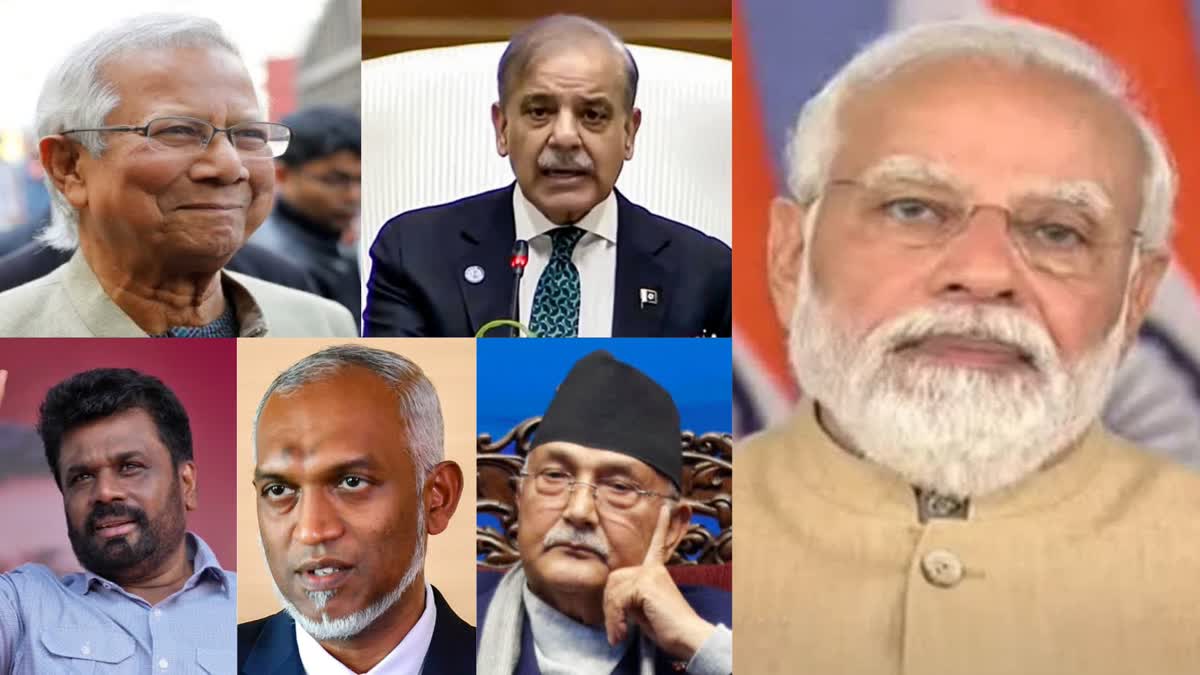New Delhi: In response to a question by Congress MP Manish Tewari during the ongoing winter parliamentary session about the challenges faced by New Delhi in its Neighbourhood First Policy, External Affairs Minister S Jaishankar said that “the Government has been extending necessary developmental assistance and capacity building initiatives, as per needs and aspirations of the neighbouring countries, thereby contributing towards holistic economic development of their countries”.
The Neighbourhood First Policy, initiated under Prime Minister Narendra Modi’s leadership in 2014, emphasises fostering stronger ties with India’s immediate neighbours, ensuring regional stability, economic integration, and mutual prosperity. The policy prioritises cooperation with countries in South Asia, including Bangladesh, Nepal, Bhutan, Sri Lanka, Myanmar, the Maldives, Pakistan, and Afghanistan.
Jaishankar said that, under this policy, India has been assisting neighbouring countries on the development of infrastructure projects ranging from large-scale infrastructure to community-related provisioning of assets and platforms, augmentation of capabilities and extending financial, budgetary and humanitarian assistance.
However, this policy came to a severe test in the year 2024 because of the political upheavals in several of India’s immediate neighbours. These include Bangladesh, Nepal, and the Maldives. This comes amidst growing Chinese influence in South Asia.
Bangladesh: Sheikh Hasina’s ouster and after
The India-Bangladesh relationship, which had flourished under Sheikh Hasina during her prime ministership for 15 years, faced turbulence in 2024 following her ouster in August this year amid mass protests over authoritarianism. An interim government led by Muhammad Yunus was installed, straining ties with India.
Hasina’s refuge in India and the rise of extremist elements in Bangladesh triggered violence against minorities, notably Hindus, prompting India’s concerns. The arrest of a Hindu monk in Chittagong worsened tensions, with Bangladesh accusing India of interference. India-financed projects stalled as bilateral ties deteriorated.
However, Foreign Secretary Vikram Misri’s visit earlier this month to Dhaka for the structured annual foreign office consultations helped restore some normalcy, reaffirming India’s commitment to a democratic and stable Bangladesh. On Bangladesh’s Victory Day on December 16, Indian leaders extended goodwill, signalling cautious optimism for future relations.
The Maldives: First the chill, then the thaw
India’s Neighbourhood First Policy faced challenges with the Maldives after pro-China leader Mohamed Muizzu won the presidency last year on an anti-India platform. Tensions escalated in January 2024 over comments by Prime Minister Narendra Modi promoting Lakshadweep tourism, which some Maldivian politicians perceived as rivalling their tourism industry, leading to social media backlash and suspension of Maldivian junior ministers.
Muizzu’s subsequent visit to China marked a departure from his predecessors’ tradition of prioritising India for state visits. However, relations improved by March, with Muizzu affirming India’s role as the Maldives’ closest ally and requesting debt relief. Positive developments followed, including his attendance at Modi’s swearing-in, continued development aid of Rs 400 crore in India's budget, and high-level visits by both sides.
In October, Muizzu’s first bilateral visit to India culminated in significant agreements, including defence and economic cooperation, and a joint vision document on comprehensive economic and maritime security.
Nepal: China’s growing influence
Nepal’s political instability and China’s growing influence remain concerns for India. The multiparty system, marked by unstable alliances and corruption, saw former Prime Minister Puspa Kamal Dahal (Prachanda) ousted in 2024, replaced by Communist Party of Nepal-Unified Marxist (CPN–UML) leader K.P. Sharma Oli in a coalition government with Nepali Congress. Breaking tradition, Oli prioritised China over India for his first state visit and signed a framework agreement to implement Belt and Road Initiative (BRI) projects.
While Nepal resisted commercial loans, seeking grants for BRI projects, China proposed “aid assistance financing”, blending grants and loans based on project risk. This flexible funding model has the potential to deepen China-Nepal ties, further troubling India, which opposes BRI due to the China-Pakistan Economic Corridor (CPEC) passing through Pakistan-occupied Kashmir and concerns over debt burdens faced by Sri Lanka and Pakistan.
Pakistan: Hostility remains
With Pakistan, the relations remain strained. Issues like the Kashmir dispute, cross-border terrorism, and political tensions continue to dominate the relationship. The downturn in bilateral ties since the 2016 Uri terror, after which no high-level bilateral talks have been held, continued. Though External Affairs Minister S Jaishankar visited Islamabad in October this year to represent India in the Shanghai Cooperation Organisation (SCO) Heads of Government meeting, no official bilateral interaction took place.
Afghanistan: Interesting developments
Though New Delhi does not recognise the Taliban regime that came to power in Afghanistan in 2021, there have been some interesting developments in terms of India’s ties with its other Western neighbour. Last month, JP Singh, Joint Secretary (Pakistan, Afghanistan, Iran) in the Ministry of External Affairs, visited Kabul during the course of which he met Afghanistan’s “acting defence minister” Mullah Muhammad Yaqoob as well as former President Hamid Karzai and other senior ministers.
According to External Affairs Ministry spokesperson, Randhir Jaiswal, Singh held talks regarding “India’s humanitarian assistance that we are providing to people in Afghanistan” and the ways the business community in Afghanistan could use Iran’s Chabahar port, in which India has significant investments, for international trade.
Soon after Singh’s visit, the Taliban-controlled Bakhtar News Agency announced that stated that the Islamic fundamentalist regime has appointed Ikramuddin Kamil, a post-doctoral student of international law from New Delhi’s South Asia University, as the “acting consul of the Islamic Emirate” in Mumbai. It remains to be seen how ties go from here.
Myanmar: Engaging with both sides
The situation in civil war-torn Myanmar continues to remain a cause of concern for New Delhi. India, despite being the world’s largest democracy, has been engaging with the military junta in Myanmar because of the ethnic conflict in Manipur and to control insurgencies in the northeastern region.
India is also concerned because of its key infrastructure projects in Myanmar like the India-Myanmar-Thailand trilateral highway and the Kaladan Multimodal Transit Transport Project (KMTTP), which connects the port of Haldia in West Bengal with the port of Sittwe in Myanmar that was built with funding from India. The corridor then links Sittwe with Paletwa town in the Chin State of Myanmar via the Kaladan river boat route. Paletwa is then linked with Mizoram by road. All components of the project, including the Sittwe port, have been completed, except the under-construction Zorinpui-Paletwa road, where work has been stalled due to the civil war in Myanmar. Paletwa is now under the control of the Arakan Army.
As such, India is also engaging with the ethnic armed organisations in Myanmar. Last month, India invited the representatives of some of these organisations for a seminar in New Delhi.
Sri Lanka: Keeping ties balanced
Sri Lanka is one country in the neighbourhood with which India managed to keep ties balanced despite a regime change. In September this year, the Indian Ocean island nation elected Anura Kumara Dissanayake of the National People’s Power (NPP) alliance as President. Though a veteran politician, Dissanayake became President only for the first time. He is the leader of the Janatha Vimukthi Peramuna or (JVP), a Marxist-Leninist party. As such there were speculations about whether he would tilt towards China if he came to power.
However, India had anticipated the rise of Dissanayake in the Sri Lankan political landscape well in advance. In fact, India had invited Dissanayake earlier this year, way ahead of the presidential election for informal interactions with the leadership in New Delhi.
Soon after the presidential election, External Affairs Minister Jaishankar visited Colombo and held a cordial meeting with Dissanayake. Following the parliamentary elections in Sri Lanka, which also saw the NPP alliance gain an absolute majority, Dissanayake came to India this month in what was his first state visit after assuming power.
Following bilateral talks between Prime Minister Modi and Dissanayake, the two sides released a joint statement titled ‘Fostering Partnerships for a Shared Future’.
Bhutan: Deep ties continue
With Bhutan too, India’s ties remained close and cordial. India continued to remain the Himalayan kingdom’s largest development aid partner. Hydropower cooperation remained a major pillar in the bilateral relationship with another India-financed mega dam close to being commissioned. Bhutan’s King Jigme Khesar Namgyel Wangchuck visited India twice this year. India also made a significant financial contribution to Bhutan’s 13th Five-Year Plan that started this year.



